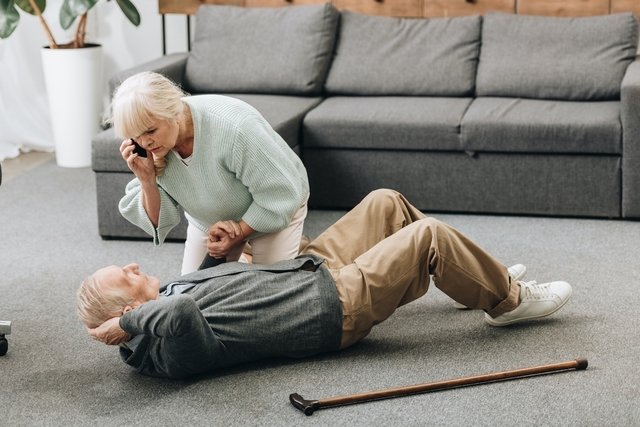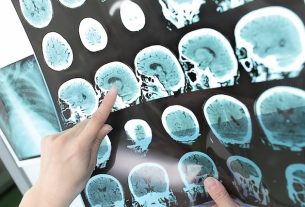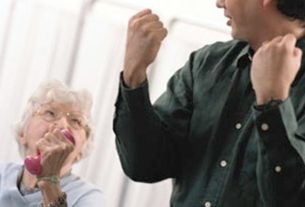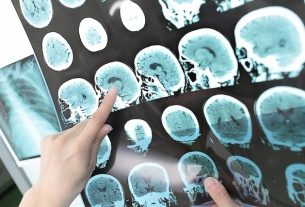In the event of a stroke, it is important that the person providing assistance remains calm and calls an ambulance. You should then place the person who suffered the stroke on their side, with their head slightly raised and supported, and check whether the person is conscious or not.
If the person becomes unconscious and stops breathing, it is recommended to start cardiac massages and perform mouth-to-mouth resuscitation until help arrives.
Stroke, called cerebrovascular accident, is a condition in which there is a reduction or interruption of the blood supply to the brain due to a blockage or rupture of a cerebral artery, leading to symptoms such as sudden and intense headache, loss of strength or movements on one side of the body, difficulty speaking, mental confusion or fainting. Know how to identify all the symptoms of stroke.

First aid step by step
Step-by-step first aid for stroke is:
- Keep calmalso calming the person with suspected stroke;
- Call an ambulancecalling number 192, informing the person’s symptoms, the location of the incident, contact telephone number and explaining what happened;
- Lay the person on their sidewith the head slightly elevated and supported, to prevent the tongue from obstructing the throat or the person from choking if they faint and vomit;
- Cover with a blanketif possible, to keep the person warm;
- Do not give food or drink to the person, to avoid choking;
- Identify the person’s complaintstrying to find out if you have any illness or if you use medication;
- Wait for helpobserving whether the person is conscious.
If the person becomes unconscious and stops breathing, it is important to:
- Start cardiac massages, supporting one hand over the other, keeping your arms straight and using your own body weight. The ideal is to do 100 to 120 compressions per minute;
- Give 2 mouth-to-mouth breathswith a pocket mask, every 30 cardiac massages;
- It is necessary to maintain resuscitation maneuversuntil the ambulance arrives.
In cases where cardiac massages are necessary, it is important to pay attention to the correct way to perform compressions. Learn how to do cardiac massage correctly.
It is always important that the person is helped immediately to avoid serious consequences, such as paralysis or loss of muscle movement, difficulty speaking or swallowing, or memory problems, for example.
How to know if it is a stroke
To be able to identify whether a person is having a stroke, you can ask them to:
- To smile: in this case, the person may have a crooked face or just a crooked mouth, with one side of the lip remaining droopy;
- Raise one arm: It is common for people with a stroke to be unable to lift their arm due to lack of strength, making it appear as if they are carrying something very heavy;
- Say a short sentence: In the case of a stroke, the person has slurred, imperceptible speech or a very low tone of voice. For example, you can ask them to repeat the phrase: “The sky is blue” or ask them to say a phrase from a song.
If the person presents any changes after giving these orders, it is possible that they have had a stroke. Furthermore, the person may experience other symptoms such as numbness on one side of the body, difficulty standing, and may even fall due to lack of muscle strength and may urinate on their clothes without even realizing it.
In some cases, the person may experience mental confusion, not understanding very simple orders such as opening their eyes or picking up a pen, in addition to having difficulty seeing and having a very severe headache. Learn how to identify 12 stroke symptoms.
Bibliography
- GET 192. Basic Life Support Protocols. 2016. Available at: <https://bvsms.saude.gov.br/bvs/publicacoes/protocolo_suporte_basico_vida.pdf>. Accessed on Aug 2, 2021
- PORTUGUESE CARDIOLOGY FOUNDATION. Stroke. 2014. Available at: <https://www.bombeiros.pt/wp-content/uploads/2014/10/acidentevascularcerebral1.pdf>. Accessed on Aug 2, 2021
- INEM. Medical emergencies. 2012. Available at: <https://www.inem.pt/wp-content/uploads/2017/06/Emerg%C3%AAncias-M%C3%A9dicas.pdf>. Accessed on Aug 2, 2021
- BAPTISTA, Nelson T. First aid manual. 3rd ed. Sintra: National Fire School, 2018. 159-174.
- MINISTRY OF HEALTH. Manual of routines for stroke care. 2013. Available at: <http://bvsms.saude.gov.br/bvs/publicacoes/manual_rotinas_para_atencao_avc.pdf>. Accessed on Aug 2, 2021




